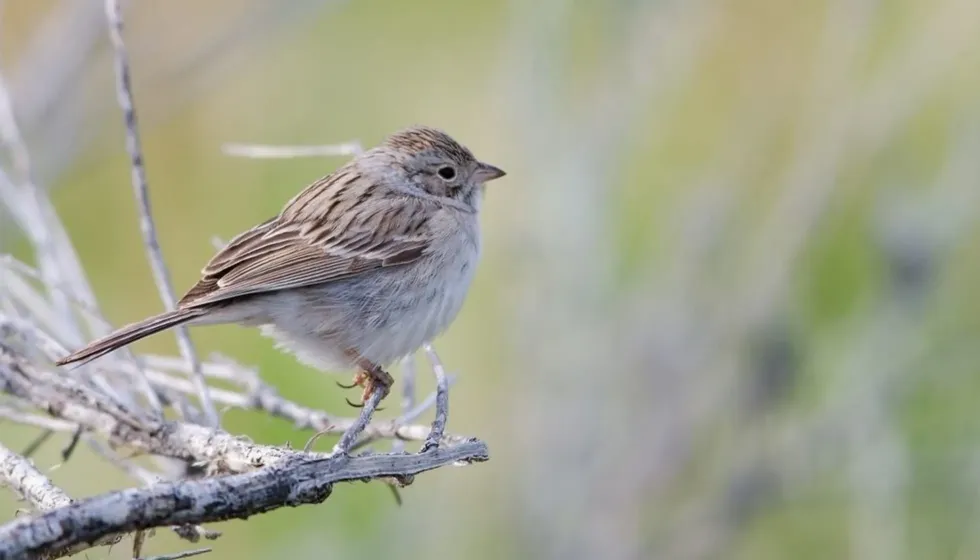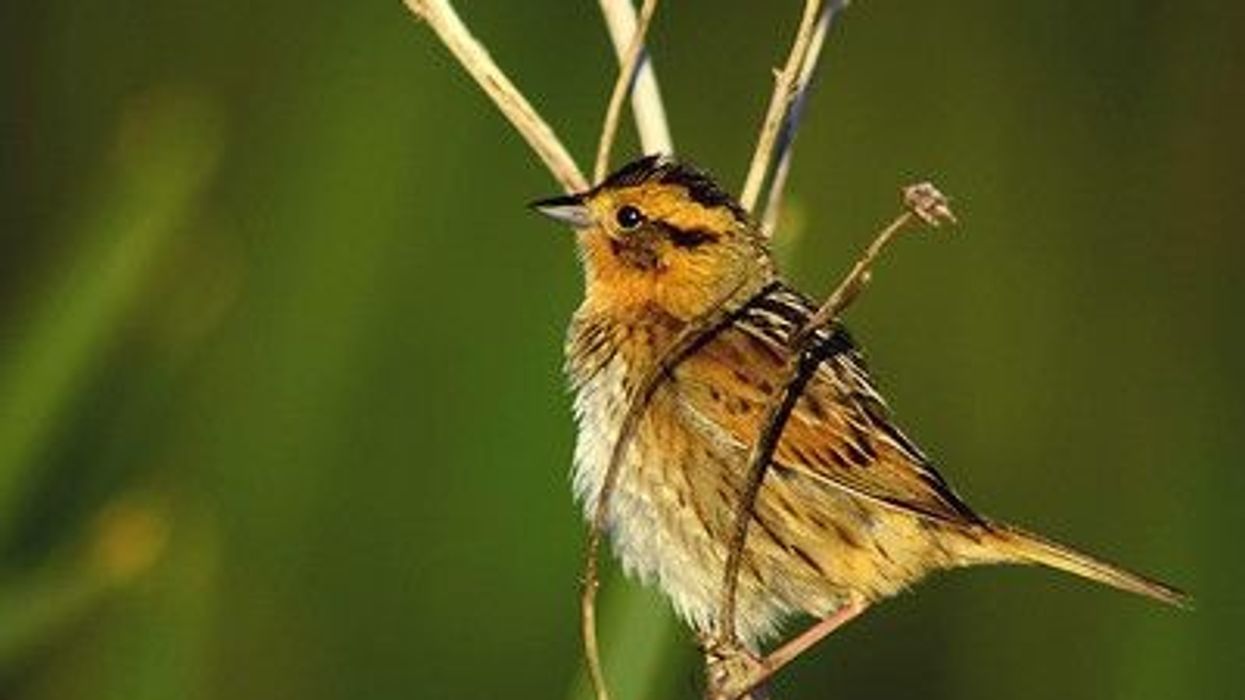The smallest species of sparrow in North America, Brewer's sparrow, is a summer bird found abundantly in the sagebrush steppes of North America. The species derived its name from Thomas Mayo Brewer, an accomplished ornithologist.
The species has been further classified into two distinct subspecies namely Brewer's sparrow (Spizella breweri breweri) and Timberline sparrow (Spizella breweri taverneri). While the first variation is widespread in sagebrush areas of western Canada, the range map of the Timberline sparrow comprises the thickets of northern Montana, Alberta, southern Yukon, southeastern Alaska, and British Columbia.
Some researchers consider the Timberline sparrow to be a separate species as the bird is larger in size and possesses a darker hue.
These birds are migratory and they primarily spend the winter in central Mexico. These sparrows are famous for their songs composed of several trills and notes.
Both long and short songs are sung by the males. They sing to protect their territories from intruders.
Continue reading to explore more about Brewer's sparrow and for some lesser-known facts about other bird species of the sparrow family, you can check out the field guide to the snow buntings and swamp sparrow.
Brewer's Sparrow Interesting Facts
What type of animal is a Brewer's sparrow?
The Brewer's sparrow (Spizella breweri) is a species of diurnal bird belonging to the order Passeriformes, family Passerellidae.
What class of animal does a Brewer's sparrow belong to?
Brewer's sparrows are members of the Aves class and Spizella genus.
How many Brewer's sparrows are there in the world?
An adult population of 16,000,000 Brewer's sparrows has been recorded throughout the world. However, for the past 40 years, a significant decreasing population trend has been observed in North America. This is mostly due to the loss of habitat.
Where does a Brewer's sparrow live?
This summer sparrow species can be found in abundance in the United States of America and western Canada although they're not endemic. In British Columbia, these birds can be traced in parts of Saskatchewan and Calgary, as well as in national forests like the Jasper National Forest and Banff National Park.
They can be spotted in several places of the southern US region including Washington, Idaho, and Montana.
Habitats near the rivers of Yellowstone and Missouri abound in the bird population.
Mexico chiefly serves as its wintering ground and the range includes Baja California. Migration to the Mexican ground can be noticed in the winter months of August to October when large flocks inhabit the region around the Pacific Coast for warmer climates.
What is a Brewer's sparrow's habitat?
The range map of Brewer's sparrow encompasses a wide variety of habitats including sagebrush steppe, grasslands, woodlands, and desert. During summer times, they tend to inhabit open sagebrush flats, pinyon-juniper woodlands, or prairies.
Who do Brewer's sparrow live with?
Brewer's sparrows are sociable birds. They can be found in pairs during the breeding period while they form flocks in the nesting season.
Even in the winter season, these sparrows flock together in desert shrubs and engage in crooning a range of songs in a mixed-up chorus. However, the species exhibits aggressive territorialism towards the male competitors during the breeding season.
How long does a Brewer's sparrow live?
The Brewer's sparrow can survive for about five years in the wilderness. The longest living Brewer's sparrow was five years and two months. After being recaptured, it was re-released in Colorado's banding site.
How do they reproduce?
Normally, these North American birds of the Passerellidae family are monogamous. Migration to breeding grounds takes place during the spring season normally from May to July. After ritualistic courtship and copulation, the males take to defending the nesting space and procuring food.
The incubation period stretches for about 11-13 days. The clutch comprises two to five eggs.
Both the male and female sparrows participate in nurturing and feeding the young birds post-hatching. Adult birds are capable of raising more than one brood annually. The young birds fledge for 12 days, after which they become independent.
What is their conservation status?
As per the International Union for Conservation of Nature (IUCN) Red List, Brewer's sparrow (Spizella breweri) of the family Passerellidae falls under the Least Concern category as the species is plentiful within its habitat range.
Brewer's Sparrow Fun Facts
What do Brewer's sparrow look like?

The Brewer's sparrow is colored in the dusky shades of gray-brown. The underparts are grayish, while there is a fine white eye-ring. The throat has a grayish-white hue and they are streaked on the nape and back.
The wingspan of the bird measures 7.1-7.9 in (18-20 cm). The Brewer's sparrow lacks the yellow mark on its head that renders a distinct appearance and identity to the golden crowned sparrow. Juvenile Brewer's sparrow exhibit pale grayish-brown coloring with a streaked underbelly.
How cute are they?
Birds are cute. They are perhaps one of the most beautiful creations of nature. Although Brewer's sparrow doesn't project a bright, colorful appearance, it undoubtedly qualifies to be adorable for its unique appearance.
How do they communicate?
The Brewer's sparrow interacts through a variety of calls and sounds but the most distinctive communication method is via a plethora of songs. Have you heard Brewer's sparrow song?
If you visit North America during the summer, you might be greeted by a range of songs of the species. In winter, these sparrows produce what can be called jumbled-up chorus songs.
Generally, a short song is produced to appease mates in the breeding period or even during migration. This short song is composed of trills in higher frequency accompanied by the lower notes that often sound like 'weeeezzz-tubitubitubitubitub'.
How big is a Brewer's sparrow ?
The Brewer's sparrow is a little bird of the Passerellidae family that can grow up to a length of about 5.1-5.9 in (13-15 cm). These North American birds are comparatively larger than the grasshopper sparrows measuring around 4.3-4.5 in (10.9-11.4 cm).
How fast can a Brewer's sparrow fly?
The speed range of the species is undeciphered but the upper elevation limit has been recorded at 6,562 ft (2000 m). Since the species belongs to the family of sparrows, it can be assumed that their average speed is somewhere around 24 mph (38.6 kph).
How much does a Brewer's sparrow weigh?
The average weight of Brewer's sparrow range from 0.4-0.5 oz (11.3-14 g).
What are their male and female names of the species?
The males and females do not have distinct names. Just like any other bird species, they're referred to as cocks and hens respectively.
What would you call a baby Brewer's sparrow?
You can refer to a baby Brewer's sparrow as a chick. It is formally called hatchling or nestling.
What do they eat?
Although Brewer's sparrow indulges in an omnivorous diet, they exhibit insectivorous tendencies. Especially during the breeding season, their diet consists of a variety of insects such as grasshoppers, leaf beetles, caterpillars, weevils, and others. These birds also consume lots of seeds mostly during the winter season. They can normally be found foraging for food among shrubs.
Are they dangerous?
Brewer's sparrows are harmless in their interactions with humans. They're hunted down by predatory birds and animals like loggerhead shrikes, chipmunks, snakes, magpies, and weasels. The pale, streaked body helps them to camouflage among shrubs. Hostile behavior has only been noticed against predators and competitors.
Would they make a good pet?
Brewer's sparrows are not reared as pets. Their behavior as a household pet is therefore undetermined.
Did you know...
Are you aware that Brewer's sparrow can thrive without a drop of water for a long time? It can survive by feeding on dry seeds.
The species plays a vital role in the ecosystem. Seeds are dispersed from the food that comprises a major portion of its diet. Habitats are greatly benefitted from the presence of these sparrows, that is, the more dense the population, the richer the foliage.
What are sparrows known for?
Sparrows are special for innumerable reasons. A sparrow is associated with symbols of teamwork, simplicity, hard work, and joy.
These small-sized birds are known to be very agile in their flight with an average speed range of 24 mph (38.6 kph). Their maximum speed is 31 mph (49.8 kph). These birds are abundantly available throughout the world.
One can easily distinguish a female sparrow from a male by its body color. The plumage of the males is normally more vibrant while the females exhibit pale shades of buff-brown all over their plumage with dull brownish-gray underparts.
Why sparrows are dying?
Although most sparrow species fall under a secure status, innumerable reasons have been associated with the drastically declining global population of sparrows. One of the major threats that have led to the diminishing population of sparrows is habitat loss.
Clearing of forest covers, human settlement and urbanization, agricultural practices, use of pesticides, pollution, and climate change offer a severe blow to these birds.
For instance, Brewer's sparrow numbers have declined by a considerable rate mainly because the sagebrush habitat has been spoiled. Food shortages and diseases have rendered these once-common birds a precarious status even though they do not qualify to the thresholds of vulnerability.
Additionally, sparrows are also hunted down by predatory birds and animals like hawks, and snakes, significantly reducing their numbers.
Conservation methods must be undertaken and implemented immediately to curb the effects of habitat loss on their population distribution. Stringent actions must be administered to ensure sustainable habitats for these little sparrows.
Here at Kidadl, we have carefully created lots of interesting family-friendly animal facts for everyone to discover! For more relatable content, check out these Radjah shelduck facts and yellow warbler facts for kids.
You can even occupy yourself at home by coloring in one of our free printable mallard duck coloring pages.










